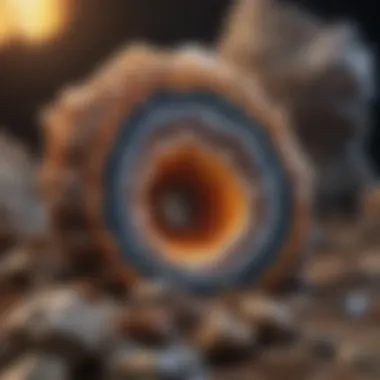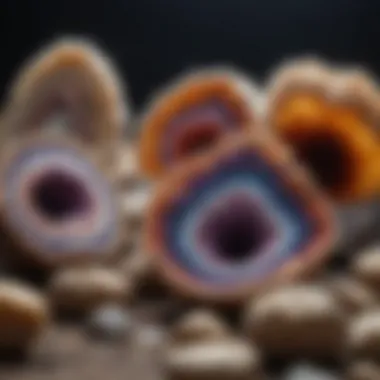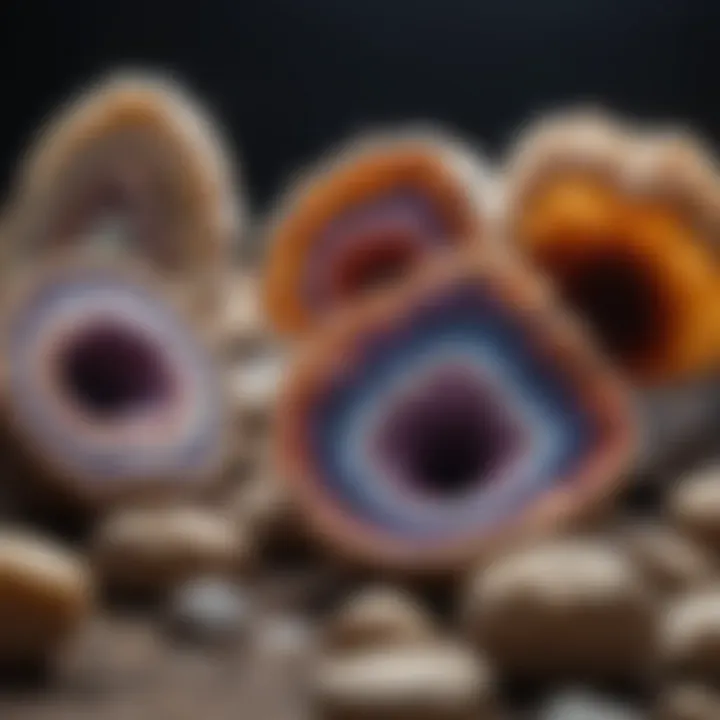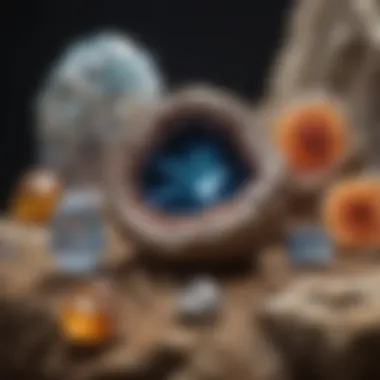The Formation of Geodes: Insights into Nature's Structures


Intro
The world of geodes is a captivating one, full of secretive formations hidden within seemingly mundane rock layers. These objects offer curious collectors and enthusiasts a glimpse into the complex processes of nature. To truly appreciate geodes, one must look beyond their exterior and understand the evolutionary tale told within their cores. This section sets the stage for a deeper dive into what these natural marvels are and how they come to be, exploring the intricate relationship between geological timescales, environmental factors, and crystal formation.
History and Origins
Geodes aren't just pretty stones; they carry stories of the Earth’s history etched in their formations. For ages, different cultures have scoured the land for these remarkable treasures. They hold a particular charm that transcends mere aesthetics, often serving as symbols of mystery and intrigue.
Overview of Collectibles, Rocks, and Fossils
Among rock collectors, geodes stand as one of the holy grails. Originally formed from mineral-rich waters that filled cavities within volcanic or sedimentary rock, these formations captivated civilizations far beyond the realm of modern geology. From ancient times, they have been prized for their beauty and believed to possess various powers. Collectors often seek them not just for their stunning interiors but also for the stories they tell about the Earth that birthed them.
Historical Significance and Cultural Impact
In multiple cultures, geodes have been interwoven with mythology and belief systems. The Greeks and Romans, for example, cherished certain gemstones that developed within these spherical formations, believing them to bring luck and prosperity. The crystal structures that often occupy these hollow spaces were sometimes used in worship, as people sought connection with the divine through natural artifacts.
The Renaissance brought about renewed interest in the natural world, prompting scholars to catalog their findings, which vastly expanded the knowledge of geodes and similar formations. Individuals like Pliny the Elder have documented such wonders. This rich history of exploration links collectors of today with those who marveled at these natural treasures centuries ago. Understanding this context adds layers of meaning to each geode—potentially connecting the owner to a lineage of curiosity about the natural world.
Identification and Classification
The ability to accurately identify and classify geodes can enhance the collecting experience, allowing enthusiasts to appreciate the diversity present within these geological formations.
Guide to Identifying Rocks and Fossils
Identifying a geode often begins with recognizing the type of surrounding rock. Common attendants of geode formations often include:
- Limestone
- Basalt
- Volcanic Tuff
These rocks often bear the tell-tale signs of geode presence—circular shapes and hard, rough textures.
Common Types and Variations
Geodes vary significantly in both size and composition, affecting their classification. Here are some notable types:
- Amethyst Geodes: Known for rich purple hues, reflecting iron compounds in the quartz.
- Agate Geodes: These feature banded appearances and can be an array of colors.
- Clear Quartz Geodes: Often preferred for spiritual and metaphysical purposes, these shine brilliantly.
Collectors often find joy in the journey of identifying these types, piecing together geological history one geode at a time. Recognizing the distinctions among them not only enhances the art of collecting but also serves as an educational trip through Earth's past, making it a rewarding endeavor for serious enthusiasts.
Prelude to Geodes
Understanding geodes is like peeling back the layers of an onion—there’s always something more to discover inside. This article aims to take a deep dive into geodes, shedding light on their formation, structure, and significance in both geological and cultural contexts. For rock and fossil collectors, they’re not just stunning decorative pieces; they serve as a window into the Earth’s history and processes.
Geodes capture the imagination with their intriguing appearance and the complexity of their formation. They encourage collectors to look beyond the surface and appreciate the natural processes at play in shaping these unique structures. By articulating the nuances of geode development, readers can develop a more profound appreciation for the Earth's geological tales.
What Are Geodes?
At their core, geodes are hollow rocks, commonly found in volcanic and sedimentary environments. Once you crack one open, you might be met with an unexpected surprise—gleaming crystals adorning the inner walls. These cavities usually form when gas bubbles in lava cool off, or when sedimentary layers create voids. It's not uncommon to find geodes lined with quartz, amethyst, or calcite, presenting a myriad of colors and shapes.
Geodes can vary significantly in size—from small pebbles to massive formations up to several feet in diameter. Their outer shells are often composed of a relatively hard material that has withstood the test of time, further protecting the delicate crystal interiors.
Historical Significance of Geodes
Geodes have held a place in human culture for centuries. Various civilizations have marvelled at their beauty and even attributed mystical properties to them. Ancient Egyptians and Romans, for instance, revered these formations not just for their aesthetic value but also for their perceived powers of protection and healing.
In more recent history, geodes have garnered attention from scientists and collectors alike. Their study not only provides insights into the geological processes of the Earth’s crust but also encourages a greater awareness of our natural environment. Rock and mineral enthusiasts often embark on quests to find these geological treasures—each geode tells a story of the conditions under which it formed.
"Geodes are a beautiful reminder that the most ordinary-seeming materials can yield extraordinary results when the right conditions come together."
In summary, the exploration of geodes—from their formation to their interpretation throughout history—opens up a dialogue about the complexities of our planet. They invite us to reflect on how seemingly mundane elements can yield extraordinary results. This inherent excitement fuels the curiosity of collectors and geologists alike.
Geological Context of Geode Formation
Understanding the geological context of geode formation is pivotal for anyone interested in this stunning natural occurrence. Geodes are not just random cavities filled with crystals; their formation is a process intricately linked to the Earth’s geological past. A deep dive into this context aids in grasping how, where, and why these formations occur, shedding light on their rarity and significance in our natural world.
Through geological events, varied conditions lead to unique environments where geodes can take shape. The interplay between volcanic activity and sedimentary processes creates a rich tapestry of potential habitats for these formations. Consequently, this understanding can inform collectors about the geographical locations where geodes may be found, and what kind of specimens they might expect.
The Role of Volcanic Activity
Volcanic activity plays a crucial role in the formation of many geodes. When magma rises to the surface, it can cool and solidify, creating pockets or cavities. These cavities often become nucleation sites for crystal growth. Here’s how it typically unfolds:
- Formation of Cavities: As volcanic eruptions occur, gases released can create bubbles in the cooling lava. The space left behind forms vacant pockets that later become geodes.
- Hydrothermal Fluids: After the formation of cavities, hot water mixed with minerals and gases seeps in. This process, known as hydrothermal activity, provides the necessary elements for crystals to grow over time, often resulting in stunning quartz or calcite formations.
This volcanic legacy is a treasure trove for collectors. Regions known for their volcanic history, like the southwestern United States, are renowned for the abundance and diversity of geodes found there.
Sedimentary Environments and Geodes
Sedimentary environments also contribute significantly to geode formation. These settings allow for a different but equally fascinating mechanism:
- Natural Sedimentation: Over time, layers of sediment can build up in basins or along riverbeds. Here, minerals carried by water can precipitate out and accumulate within cavities formed by the erosive forces of water.
- Calcium Carbonate Sources: In some instances, geodes form in limestone areas where calcium carbonate is present. As water seeps through these geological formations, it can become saturated with minerals that later solidify into crystals when conditions are right.
Interestingly, the subtle variances in sedimentary environments lead to diverse mineral compositions within geodes. This means that two geodes formed in different settings can present entirely different characteristics, appealing to collectors who seek variety.


"Geodes form not just through one specific process but rather through the marriage of various geological conditions that happen over long periods. Every geode tells a story of the Earth's dynamic nature."
In summary, the geological context of geode formation emphasizes the complexity and beauty of Earth’s natural processes. By understanding both volcanic and sedimentary influences, collectors and enthusiasts can appreciate not only their aesthetic value but also their geological significance. Such insights pave the way for a deeper connection with the environment and the remarkable treasures it holds.
The Physical Structure of Geodes
Understanding the physical structure of geodes is paramount. This section reveals how their unique formations arise from geological processes over time, exhibiting fascinating characteristics that attract collectors and researchers alike. The interplay between internal and external attributes lays the groundwork for comprehending not only the beauty of these formations but also their scientific significance.
Inner Cavities and Crystal Growth
At the core of every geode lies its inner cavity, an enchanting space where crystal growth takes place. As mineral-enriched water seeps into these cavities, it deposits various minerals when conditions are just right. Often, this process unfolds over thousands, even millions, of years. As the water cools and evaporates, the minerals crystallize, exhibiting a spectacle of shapes and colors.
The most common crystals found include quartz, amethyst, and calcite—each bringing its own distinct character. The geometry of these crystals varies widely, leading to a multitude of forms such as points, clusters, or even drusy surfaces. Some observers argue that the quality of the crystals reflects the environmental conditions present during growth, which can range from steady to tumultuous.
Influential factors like temperature and pH level can drastically affect the crystalline outcome, making it an ever-fascinating subject of study. Collectors prize geodes for the individual stories each one tells about its formation conditions.
"The beauty of a geode's inner chamber lies not just in its looks, but in the narrative of resilience and time it embodies."
External Characteristics of Geodes
The outer appearances of geodes serve as a prelude to the wonders within. At first glance, a geode might seem like an ordinary rock. However, its exterior often hints at the treasures concealed inside. They frequently boast rugged, unadorned surfaces, typically creating an aura of mystery. The color and texture of a geode's exterior can depend on the mineral composition from whence it originated.
When collected and cut open, the contrast between the rough exterior and the vibrant crystalline interior can be quite striking. Some may find it interesting that the presence of iron oxide can lend a rusty hue to many geodes, adding to their visual appeal.
Fascinatingly, the exact shape of a geode can vary dramatically as well. Common shapes include spherical, oval, and even elongated forms, all dictated by the environment where they formed. Understanding these external characteristics not only enhances appreciation of geodes but also assists in categorizing them for further exploration by enthusiasts of geology.
In summary, the physical structure of geodes showcases a complex relationship between their inner and outer realms, each part significant in forming the overall aesthetic and scientific relevance. Their diverse structures invite curiosity, providing fertile ground for further research and appreciation in the world of natural artifacts.
Mineral Composition of Geodes
Understanding the mineral composition of geodes is essential for anyone delving into their formation. The unique characteristics of these geodes depend heavily on the types of minerals that fill their inner cavities. Not only do these minerals add beauty to the geodes, but they also tell a story about the geological history of the area where they formed. By studying the mineral composition, collectors can gain insights into the environments in which these geological wonders originated.
Common Minerals Found in Geodes
When it comes to geodes, certain minerals are like old friends that show up time and again. Here are a few of the most common ones:
- Quartz: One of the most frequent minerals found in geodes, quartz typically forms beautiful, sparkling crystals inside the cavities. Its durability and abundance have made it a staple in the geode family.
- Calcite: This mineral can take on a variety of forms and is known for its distinctive rhombohedral crystals. Calcite is sometimes present as a primary component, or it can occur alongside other minerals within the geode.
- Amethyst: A variant of quartz, amethyst is cherished for its vibrant purple hue. When found in geodes, it often showcases stunning crystal formations that can catch any collector's eye.
- Agate: This striking banded chalcedony is formed in layers. Agate can provide a captivating visual tale of the geode’s formation, with its swirling colors presenting a feast for the eyes.
Besides these, you might also stumble upon minerals such as barite and celestine, adding even more diversity to the geode's internal landscape.
Rare Minerals and Their Significance
While common minerals definitely possess their own charm, it’s often the rare minerals that ignite the passion of collectors. Discovering these elusive gems within a geode can be somewhat like finding a needle in a haystack, but their significance is monumental.
- Fluorite: Known for its vibrant colors ranging from purple to blue, fluorite can sometimes be found in geodes. It is often sought after not just for its aesthetic value but also due to its unique structure that helps researchers understand geological processes.
- Malachite: This striking green mineral can form in copper deposits and is occasionally encountered within geode formations, providing a stark contrast to quartz or calcite.
- Citrine: A rare, yellow-tinted variant of quartz, citrine brings warmth and vibrancy. Its presence in a geode is often valued not just for beauty but also for its purported metaphysical properties.
- Prehnite: While not always found, prehnite adds a distinctive touch with its pale green hue. It is appreciated for both its rarity and its role in revealing the geode's formation process.
Collecting rare minerals can be a thrilling adventure for enthusiasts. Each discovery tells stories of ancient environments and geological transformations, painting a broader picture of Earth’s rich history.
"The mineral composition of geodes is much more than aesthetics; it represents millions of years of geological evolution and offers a glimpse into the past."
As we explore the intricacies of geodes, considering the various minerals present not only enhances our appreciation of these natural works of art but also connects us to the larger narrative of our planet's history.
The Chemical Processes Behind Formation
Understanding the chemical processes involved in the formation of geodes is crucial for anyone interested in their unique beauty and complexity. Geodes, often found in volcanic or sedimentary rock, arise through a series of intricate chemical interactions that create the breathtaking crystalline interiors we admire.
The Role of Hydrothermal Solutions
Hydrothermal solutions play a vital role in the creation of geodes. These solutions are primarily hot, mineral-rich waters that seep through rock formations due to volcanic activity or geothermal processes. As these fluids move through the cracks and voids in rock, they dissolve minerals and carry them along to cooler areas where they can precipitate out.
For example, when hydrothermal solutions cool, they may deposit silica, calcite, or other minerals, leading to the of crystals often seen in geodes. This process functions almost like baking a cake; as the batter (hydrothermal fluid) fills the pan (the void in the rock), it gradually changes consistency as it spreads and cools. Over time, this mixture crystallizes and can create stunning formations within the geode.
A key aspect of hydrothermal solutions is the temperature and pressure at which they operate. Hotter solutions hold more dissolved minerals, while changing pressures alter how and when these minerals will crystallize. This interplay directly influences the final appearance of the geodes, from the types of crystals formed to their arrangement.
"The wonders of geology lie not only in the rock itself, but also in the unseen processes that bring them to life."
Evaporative Processes Leading to Geodes
Evaporative processes also contribute significantly to geode formation, especially in arid environments. When bodies of water—such as lakes or shallow seas—evaporate, they leave behind dissolved salts and minerals concentrated in the remaining water. As evaporation continues, these minerals can precipitate out and form nodules or crystalline structures.
For instance, in desert regions, the harsh sun can cause surface water to evaporate quickly, leading to the formation of geodes enriched with minerals like halite or gypsum. In these instances, although the initial conditions differ from those influenced by hydrothermal solutions, both methods ultimately contribute to the classic geode structure.
The environmental setting is crucial in this stage. Seasonal changes or climate variations can affect water levels, altering the concentration of minerals and influencing growth patterns. This intricate dance of evaporation, saturation, and precipitation results in the captivating diversity of geodes found across various landscapes.
By grasping these chemical processes, hobbyists and collectors can appreciate not just the aesthetic allure of geodes, but also the geological history woven into their formation. Understanding how these natural artifacts come to be can deepen one’s respect and admiration for the Earth’s dynamic processes.
The Environmental Factors Affecting Geode Formation
The formation of geodes is not merely a tale of mineral composition and hydrological processes; it also hinges crucially on environmental factors. These elements act like the puppet strings, guiding the intricate dance of crystal growth and defining the final character of a geode. Understanding these factors—temperature, pressure, and the unique conditions surrounding each formation site—can unveil important insights for collectors, geologists, and hobbyists alike.
Temperature Influences on Growth


Temperature plays a vital and often overlooked role in the formation of geodes. Generally, higher temperatures can accelerate the process of mineral deposition. In most cases, the internal temperature of the earth can increase by approximately 25 to 30 degrees Fahrenheit for every mile of descent. This thermal gradient creates warm pockets in volcanic or hydrothermal environments where geodes are likely to develop.
As the temperature rises, the solubility of minerals in water also changes. Warmer water can hold more dissolved minerals, which in turn may lead to increased crystal formation. For example, in some active geothermal areas, geodes filled with quartz or calcite can grow more rapidly due to the higher thermal energy that promotes precipitation.
Conversely, in cooler environments, crystal growth tends to slow. The initial nucleation—where the crystals first form—remains stagnant in colder conditions, leading to smaller or less vibrant crystals. Therefore, a geode from a cooler habitat may be more modest in scale compared to those from temperate or hot regions.
Pressure Conditions in Geode Development
Pressure is another influential factor that shapes geode formation. It acts in tandem with temperature, providing the conditions necessary for the creation of spatial stress within rocks, which can facilitate the development of cavities—key spaces where geodes flourish.
In environments with increased tectonic activity, such as subduction zones or fault lines, the pressure and geological movements can create cavities in rocks, allowing for the accumulation of mineral-rich fluids. Interestingly, this pressure can enhance the crystallization process; minerals have a tendency to arrange into ordered patterns under pressure, leading to well-structured formations.
Moreover, the depth at which a geode forms significantly impacts its characteristics. For instance, those formed deep within the Earth will typically experience high pressure and heat, resulting in larger crystals and more complex internal structures. In contrast, shallower formations may have less pronounced crystal growth due to the lesser pressure.
"A geode is not merely a hollow rock; it tells the story of the environment in which it developed."
Geodes in Different Geological Settings
Geodes are not just random occurrences in the natural world; their formation is greatly influenced by the geological setting in which they arise. Understanding these various settings is key for rock and fossil collectors who seek to appreciate the intricacies of geodes. Each environment offers unique characteristics that shape the geodes, from their size and mineral composition to the conditions that govern their growth. Evaluating the differences between geodes formed in diverse locations can provide valuable insight into their formation processes and assist collectors in identifying specimens.
Desert Geodes vs. Rainforest Geodes
Desert settings and rainforests create markedly different environments for geode formation. In arid desert regions, geodes often develop in volcanic rock or sedimentary deposits, where the scarcity of moisture can lead to concentrated mineral deposits. This drought-like environment promotes the formation of larger specimens, as mineral-rich water that evaporates can leave behind a precious treasure within the encasing rock. These desert geodes may showcase stunning quartz crystals or agate-rich interiors, often reflecting vibrant colors, due to the minerals precipitating in the heat.
On the other hand, rainforest geodes benefit from the humid climate that pervades most tropical regions. Here, the constant availability of water allows for a different set of minerals to dissolve and crystallize. The lush surroundings often make for smaller and more intricate geodes, filled with diverse mineral species that require steady moisture for formation, such as calcite or amethyst. In this relegated habitat, the intricate layering of mineral crystallization results in visually captivating patterns and forms. Furthermore, the biodiversity in these ecosystems sometimes leads to the presence of organic materials within the geodes, an intriguing aspect for dedicated collectors.
"The environment plays a pivotal role in the mineral content and quality of geodes; understanding this can elevate the appreciation of any geode collection."
Geodes in Limestone Formations
Limestone formations present a fascinating geological context for geode development. These sedimentary rocks are generally composed of calcium carbonate and can produce geodes when conditions are right. The porous nature of limestone allows for water to permeate the rock and dissolve the minerals within. As groundwater rich in various mineral components flows through the limestone, it can deposit these minerals in hollow cavities, eventually giving rise to geodes filled with stunning crystals.
The significance of limestone geodes lies not only in their aesthetic appeal but also in their mineralogical variety. Collectors often find geodes containing calcite, aragonite, and even rarity such as dolomite crystals. The unique acid-alkaline reactions occurring within limestone can further alter the growth patterns of crystals, leading to a diverse range of appearances. These geodes may have a mottled look, attributed to the varied mineral deposits layered within — a true testament to the interaction between water, minerals, and the geological substrate.
In summary, understanding geodes in various geological settings opens doors to a broader perspective. The environmental nuances influence not only the formation processes but also the aesthetics and chemical makeup of geodes. For those invested in collecting, this knowledge broadens not just technical expertise but enhances the storytelling aspect of each mineral specimen.
The Role of Water in Geode Formation
Water stands as a key player in the genesis of geodes, weaving its way through various processes that shape these unique geological structures. In the world of geology, the significance of water cannot be overstated. From initiating crystal growth to influencing the entirety of mineral composition, it acts as a vital medium that contributes to the elegance we observe in geodes today. This section delves into the intricate relationships between water and geodes, focusing particularly on the nuances of groundwater systems, along with capillary actions that are pivotal during geode formation.
Groundwater Influence on Crystal Development
Groundwater is much more than just a collection of subterranean O; it serves as a crucial agent in the evolution of geodes. As water seeps through cracks in the earth, it carries a cocktail of dissolved minerals, often picked up from surrounding rocks. Over time, this mineral-rich water permeates into cavities within volcanic or sedimentary rocks, facilitating the growth of crystals. This slow saturation process can result in striking formations of quartz, calcite, and various other minerals.
Interestingly, the conditions that affect crystal growth are heavily dependent on the properties of groundwater. For instance, temperature and pressure within the earth’s crust can dramatically modify how water interacts with minerals in geodes. If groundwater is heated through geothermal activity, it can increase the solubility of certain minerals, allowing for a more rapid influx into cavities, subsequently accelerating the crystal development process.
- Here are some distinctive elements of how groundwater influences crystal growth:
- Mineral Saturation: The number and type of minerals dissolved can directly determine the nature of the crystals formed.
- Temperature Variations: As underground temperatures change, the rate at which crystals form can vary, influencing the size and clarity of the crystals.
- Pressure Conditions: Increased pressure can lead to more compact crystal structures, enhancing their structural integrity.
Water, being the life force behind mineral transport, truly shapes the fabric of geodes. The interaction between minerals and water leads to the intricate beauty often seen when one cracks open a geode.
Capillary Actions and Geode Growth
Capillary action is another fascinating phenomenon that exhibits how water contributes to geode formation. This process occurs when water rises through small openings and materials within the geode, facilitating mineral deposition even in areas that may seem unreachable.
In essence, as water naturally rises due to capillary forces, it can carry dissolved minerals along with it. When water evaporates within these small cavities, minerals can precipitate out, gradually building up crystal layers in a methodical fashion. This slow buildup allows for the formation of diverse and often complex crystalline structures.
"Capillary action, while unseen, elegantly directs the growth of minerals in hidden pockets, crafting the stunning designs that captivare geologists and collectors alike."
For collectors, understanding capillary actions provides deeper insights into the aesthetics of geodes. Each formation tells a tale of specific environmental conditions and fluid dynamics at play, reflecting the journey minerals have taken through the earth.
In summary, without the involvement of water in its various forms—both as groundwater and through capillary action—the enchanting beauty and uniqueness of geodes would remain a mere fantasy. Collectors and enthusiasts alike can truly appreciate these natural wonders with a keen awareness of the processes that brought them into existence.
Studying Geodes: Tools and Techniques
Studying geodes is a multifaceted venture that combines both fieldwork and laboratory analysis. With the right tools and techniques, researchers can uncover the mysteries behind these geological formations, providing valuable insights into their origin, structure, and mineral composition. This section underscores the significance of a systematic approach to studying geodes, emphasizing the benefits of employing modern techniques and the keen observational skills required by the geologist or enthusiast.
Field Methods for Geode Exploration
To begin the adventure of exploring geodes, several field methods can serve as invaluable guides. First and foremost is visual inspection. Glistening surfaces or unusual shapes can often lead one to potential geode locations. In this regard, local geological maps can also be vital resources. They often detail where specific rock formations are found, hinting at possible geode-rich areas.
Another effective method is prospecting with tools such as rock hammers and chisels. Breaking open rocks using these tools might reveal hidden geodes waiting just beneath the surface. The thrill of the hunt is paired with a need for safety precautions; heavy gloves and protective eyewear should always be on hand to avoid mishaps.
Alongside traditional prospecting, enthusiasts might benefit from GPS technology. Using GPS devices can help document prime locations for future visits. This tech-savvy approach, while modern, taps into an ancient quest for knowledge - understanding the earth’s secrets. Field teams can also utilize geophysical surveys, employing methods like ground penetrating radar (GPR) to detect voids beneath surfaces, aiding in the identification of geode hotspots without needing to dig haphazardly.
Laboratory Analysis of Geode Samples
Once a geode has been collected, the next stage involves heading to the laboratory for detailed analysis. X-ray diffraction (XRD) is one of the primary techniques used to reveal the mineralogical composition of geode samples. This method allows researchers to identify the crystalline structures within the geodes, offering clues about the conditions under which they formed.
Another crucial technique is scanning electron microscopy (SEM). This method provides high-resolution images of the geode’s internal structure, uncovering the intricate patterns of crystal growth that are often unnoticed by the naked eye. Through these methods, scholars can not only identify common minerals but also spotlight rare ones that contribute to the geode's unique characteristics.


Furthermore, elemental analysis, often conducted via techniques like energy dispersive X-ray spectroscopy (EDX), can give insight into the chemical compositions of minerals found within the geode. This analysis can play a pivotal role in understanding how environmental factors influenced the formation processes.
"The intersection of field and lab work opens a broader understanding of geode formation, moving beyond mere collections to a scientific narrative about nature's artistry."
Understanding the tools and techniques to study geodes enriches not only geological knowledge but also deepens the appreciation for natural beauty. A voyage from untamed landscapes to the precise confines of a lab reflects the timeless human pursuit of exploration and understanding.
The Cultural Significance of Geodes
Geodes hold a unique cultural significance that extends far beyond their geological beauty. They are not just striking formations of minerals and crystals; they also embody rich stories and traditions across different civilizations. The importance of these fascinating structures lies in their dual role as both scientific specimens and treasured artifacts, which can serve to connect us to the natural world and to each other.
Geodes in Art and Folklore
Throughout history, geodes have captured the imagination of artists and storytellers alike. From ancient cultures to contemporary creators, these stone formations often symbolize mystery and protection. In many folklore tales, geodes are seen as protective amulets, believed to guard the wearer against negative energies and ill fortune.
Artists frequently draw inspiration from the unique patterns and internal formations of geodes. Their vibrant colors and stunning crystal structures often find their way into modern designs, whether in jewelry or home décor. An interesting note is that the art of geode-inspired crafts has surged recently. Many artisans emphasize using natural stones to enhance the beauty of their works, creating one-of-a-kind pieces that resonate with both aesthetic appeal and an appreciation for nature's artistry.
These sparkling formations, like those found in places such as the Keokuk Geode Beds in Iowa or the Quartzsite area of Arizona, are celebrated in various regional art forms, strengthening community identity and heritage. In another cultural context, ancient civilizations viewed crystals as sacred. The Native American tribes, for example, have long regarded certain stones, including geodes, as having healing properties. This reflects a deep respect for natural elements, which can be seen in their rituals and art.
The Appeal to Collectors
Collectors around the world have a particular fondness for geodes. The sheer variety of shapes, sizes, and crystal configurations captures the essence of what makes geological collecting so compelling. For many hobbyists, the hunt for unique specimens becomes a personal quest, sometimes likened to treasure hunting. This pursuit not only fuels enthusiasm but also fosters a community of like-minded individuals who share a common passion.
The appeal of geodes often lies in their ability to surprise and delight. The outer appearance frequently gives no indication of the intricate beauty inside. A rough, unassuming exterior can conceal the most vibrant and beautifully arranged crystals, making each discovery a moment of wonder. This unpredictability invites collectors to explore the mystery behind each stone, igniting curiosity and engagement with geology.
Moreover, educating oneself about geode formation and characteristics enhances the collection experience. Certain collectors go so far as to study locations renowned for their distinctive geodes, such as the famous geode deposits in Brazil or the striking Amethyst geodes found in Uruguay.
Conservation and Ethical Considerations
The fascination with geodes extends beyond merely collecting them. There are significant conservation and ethical considerations that should concern any rock and fossil enthusiast. As natural formations, geodes serve as essential components of our environment, embodying geological history that tells tales of Earth’s past. Preservation is vital not only for educational purposes but also for maintaining biodiversity and the integrity of ecosystems where these remarkable structures are found.
Sustainable Collecting Practices
When it comes to collecting geodes, sustainable practices should be front and center in every collector's mind. Here are some ideas to consider when you find yourself tempted to excavate:
- Limit Your Impact: Only collect where allowed, and be mindful of the number of geodes taken. Leaving some behind is respectful to both nature and fellow collectors.
- Use Appropriate Tools: Instead of heavy machinery that can cause significant landscape disruption, opt for basic hand tools. Hammer and chisel set typically does the trick nicely.
- Educate Yourself: Understanding the ecosystem where you are collecting can help you make wise choices. For instance, many desert areas are delicate, and over-collecting can lead to degradation.
Adopting these practices benefits not just the local geology but can also ensure that future collectors may enjoy the thrill of finding a geode as well.
Legalities Surrounding Geode Excavation
Besides the ethical considerations, legal aspects play a critical role in how and where geodes can be collected. Laws vary widely by jurisdiction. Here are things to keep in mind:
- Know the Rules: Always familiarize yourself with local and federal regulations concerning rock collecting. Some regions require permits, while others have outright restrictions against extraction.
- Protected Areas: Geodes found within national parks or protected reserves are off-limits for collection. Respect these rules to prevent severe penalties and to help protect these natural treasures.
- Private Land: If you’re considering collecting geodes on private property, secure the owner's permission first. Trespassing can result in legal consequences.
"Respect for the law is a fundamental aspect of responsible collecting; a clear understanding of what is permissible can lead to improved conservation practices."
By acknowledging both sustainable practices and legal frameworks, geode collectors can enjoy their passion without contributing to environmental degradation. Engaging in responsible collection ensures that these extraordinary geological formations remain part of our world for generations to come.
Future Directions in Geode Research
As our understanding of geodes continues to evolve, various perspectives emerge regarding their formation and significance. Research in this area not only enhances our scientific knowledge but paves the way for potential breakthroughs that could reshape how we comprehend geological processes. Geodes, with their captivating crystal formations and intricate structures, present a unique focus for future studies, especially considering their importance in geology and mineralogy.
Advancements in Geochemical Analysis
In recent years, advancements in geochemical analysis have opened up new avenues for studying geodes. Researchers are now employing sophisticated techniques like laser ablation inductively coupled plasma mass spectrometry (LA-ICP-MS) to analyze the trace elements within geode mineralogy. This method allows for high-resolution spatial analysis, providing insights into how crystals form and develop over time.
The implications of these advancements are significant. Understanding the elemental composition can help scientists trace back the environmental conditions during the geode's formation. For instance, variations in the concentration of certain elements might indicate changes in temperature or pressure over time.
"The study of geochemical elements can serve as a window into the past, revealing how geodes formed in response to different geological events."
Potential Discoveries in Unexplored Regions
While some regions renowned for geode deposits are well-studied, many others remain largely untouched. The potential for groundbreaking discoveries in unexplored territories is immense. For example, remote areas in regions like South America or parts of Central Asia could harbor geodes with unique mineral compositions and crystal structures, yet to be discovered.
Exploring these areas not only fuels the curiosity of scientists and collectors alike but also enhances our knowledge of the Earth's geological variability. Often, the most remarkable finds tend to emerge from locations where few have ventured. This underscores the importance of fieldwork and further exploration in geology.
- New locations could yield:
- Rare mineral varieties that enrich the understanding of geode formation.
- Unique structural features that reflect different environmental histories.
By tapping into these largely unexplored regions, researchers can enhance the collective understanding of geological processes and potentially discover new minerals that could have broader implications for fields such as material science or environmental studies.
Ending
The conclusion of this article emphasizes the intricate nature of geodes and their formation. Understanding the processes that create these stunning natural artifacts is more than just academic curiosity; it connects us, as collectors and enthusiasts, to the very heart of our planet’s geological activity. Geodes are not merely geological formations; they represent narratives of Earth’s history, capturing events that transpired over millennia.
Recap of Key Points
To summarize, several core elements emerged in the discussion:
- Geological Context: The interplay of volcanic activity, sedimentary environments, and mineral composition is critical to geode formation.
- Crystal Growth: Inner cavities developed through dynamic environmental factors lead to the growth of crystals, showcasing the wonders of nature.
- Chemical Processes: Hydrothermal solutions and evaporative processes are significant players in shaping the geode's structure.
- Environmental Factors: Variations in temperature and pressure create the perfect conditions for crystal development.
- Cultural Significance: Beyond their geological appeal, geodes hold a unique value in art, folklore, and the collector’s market.
Understanding these elements informs our appreciation of geodes and their significance.
Final Thoughts on Geodes
In closing, geodes stand as a fascinating testament to nature's artistry. Each geode tells a distinct story, inviting collectors and scientists alike to explore their beauty and complexity. As we peel back the layers of their formation, we engage with a dialogue that transcends time and space. Collecting geodes is not just about ownership—it's about stewardship, education, and respect for the natural processes that formed them. As collectors, we hold the privilege of curating these natural wonders, but we must do so ethically and sustainably, ensuring future generations can also admire these exquisite geological treasures.
As we cast our gaze toward future studies in geodes, the potential for discoveries in unexplored regions is abundant. Integrating advancements in geochemical analysis with a sense of stewardship raises a crucial question: How can we deepen our connection to the Earth through the collection and appreciation of geodes? This ongoing journey of discovery will only propel the fascination with geodes further, solidifying their position as remarkable natural artifacts.



